
The European market potential for swimwear
The value of European swimwear imports is estimated at €2.16 billion, making it a relatively small apparel subsegment. However, ITC Trade map statistics valued the European share of total world swimwear imports as high as 42% in 2022, compared to a 28% share for the USA. Women’s and girls’ swimwear imports offer the biggest opportunity, accounting for as much as 75% of this market.
Markets with the best opportunities for importing swimwear to the EU include Germany, France, Italy, Spain, the Netherlands and Poland. These countries are the biggest importers of swimwear in the EU and (with the exception of Poland) amongst the biggest importers of swimwear from developing countries. While Western and Northern European countries show higher potential for market entry than Eastern European countries, Poland stands out with high growth in recent years.
Contents of this page
1. Product description
Swimwear describes items of clothing designed to be worn by people engaging in beach or water-based activities or sports, such as swimming, diving, beach volleyball and surfing, or sun-oriented activities, such as sun-bathing.
Different styles may be worn by men, women and children. The choice of style and colour is based on personal preference, personal or community standards of modesty, the activity and any additional functionality required by the wearer. In general, however, swimwear covers at least the wearer’s crotch area and, for females, usually covers at least the nipples.
The product category can be broken down into 2 subsegments: men’s and boys’ swimwear and women’s and girls’ swimwear. Within these subsegments, there are different HS codes for garments that are knitted or woven, garments made of synthetic or other textile materials and garments that contain 5% or more by weight of rubber thread.
|
HS CODE (8-digit) |
Men’s / women’s |
Knitted / woven |
Fibre |
Description |
|
61123110 |
Men’s |
Knitted |
Synthetic |
≥ 5% rubber thread |
|
61123190 |
Men’s |
Knitted |
Synthetic |
<5% rubber thread |
|
61123910 |
Men’s |
Knitted |
Non-synthetic |
≥ 5% rubber thread |
|
61123990 |
Men’s |
Knitted |
Non-synthetic |
<5% rubber thread |
|
62111100 |
Men’s |
Woven |
All |
N/A |
|
61124110 |
Women’s |
Knitted |
Synthetic |
≥ 5% rubber thread |
|
61124190 |
Women’s |
Knitted |
Synthetic |
<5% rubber thread |
|
61124910 |
Women’s |
Knitted |
Non-synthetic |
≥ 5% rubber thread |
|
61124990 |
Women’s |
Knitted |
Non-synthetic |
<5% rubber thread |
|
62111200 |
Women’s |
Woven |
All |
N/A |
Figure 1: Spending a summer day at the beach is a popular pastime for many European men, women and children

Source: Photo by Vidar Nordli-Mathisen on Unsplash
2. What makes Europe an interesting market for swimwear?
Europe is a significant global importer of swimwear. In 2022, the value of swimwear imports to Europe, including intra-EU imports, amounted to €2.16 billion. This was up from €1.61 billion in 2017 and corresponds to roughly 389 million units of clothing (up from 336 million in 2017). Over the 2017-2022 period, the value of European swimwear imports grew at an average annual rate of 6.11%, falling just under the 6.75% average growth rate of all EU apparel imports.
According to Eurostat, the percentage of the EU population aged 15 years and over that was keeping fit or engaging in recreational physical activities at least once a week was 44.3% in 2019. As awareness of the benefits (physical and psychological) of engaging in recreational sports and maintaining a healthy lifestyle continues to grow, demand for a range of sport-related apparel is also expected to increase in the coming years.
Statista predicts the European sport and outdoor market will grow by an average of 8.73% per year in the 2023-2027 period. Swimming is amongst the top 4 sport activities that European adults regularly participate in (alongside hiking, cycling and running).
The Lloyd’s Register Foundation World Risk Poll (available at wrp.lrfoundation.org.uk/data-resources) concludes that the percentage of Europeans that are able to swim unassisted significantly exceeds the global average of 57% for men and 32% for women. Within Europe, Eastern Europeans have the lowest rates of able swimmers (84% and 58%), followed by Southern Europeans (85% and 70%) whilst North/Western Europeans are the most able swimmers within Europe (89% and 85%).
Data published in the State of the Climate in Europe Report indicates that temperatures in Europe increased at more than twice the global average over the 1991-2021 period, averaging +0.5 °C per decade, which is the highest of any continent worldwide. Europe’s ten warmest years on record all occurred since 2000, and the 5 warmest years all since 2014.
Source: Eurostat
With a 75% market share, the women’s and girls’ swimwear subsegment is by far the largest subsegment and has remained stable over the 2017-2022 period.
The knitted swimwear category is far larger than the woven category, accounting for a 77% share of market value in 2022. The woven category mainly consists of men’s and boy’s swim shorts: 70% of all woven swimwear is for men and boys and 64% of all men’s and boy’s swimwear is woven, up from 54% in 2017. This increase is likely due to an increased availability of ‘transitional’ swim short styles (less form-fitting shorts that can be worn both as casual shorts and in the water). By contrast, only 32% of women’s and girls’ swimwear is woven.
Table 1: Swimwear imports to EU by gender subsegment, 2022 EUR value, % share of swimwear, average 5-year compound growth
|
Subsegment |
Value in euros |
% share of swimwear |
5-year growth |
|
Men's & boy's |
545 m |
25% |
6.99% |
|
Women's & girls’ |
1.62 bn |
75% |
5.83% |
|
All swimwear |
2.16 bn |
100% |
6.11% |
Source: Eurostat
The EU is also a large exporter and re-exporter of swimwear apparel. In 2022, it exported €1.6 billion worth of swimwear products (up from €1.14 billion in 2017). The EU swimwear export market grew at an average yearly rate of 7% between 2017 and 2022. The biggest EU exporters in 2022 were Germany (€303 million), Italy (€244 million), the Netherlands (€193 million), France (€191 million), Poland (€152 million) and Spain (€108 million). Together, these 6 countries represent over 74% of EU swimwear exports. Within this group, Spain, Poland and Italy saw the strongest export growth in the 2017-2022 period, averaging 14.5%, 13.4% and 12.3%, respectively, per year.
Source: Eurostat
Currently, the value of EU swimwear imports is relatively evenly split between swimwear originating from inside and from outside the EU, at 52.5% and 47.5%, respectively.
In 2022, developing country suppliers accounted for 45% of the value of all swimwear imports into the European Union (EU) (up from 43.5% in 2017). Suppliers from the rest of the world accounted for just 2.3% of the total import value (down from 6.5% in 2017). The value of EU swimwear imports from developing countries was €978 million in 2022 and has increased at an average yearly rate of 6.9% since 2017 (almost 1 percentage point higher than the swimwear segment overall).
During the same period, swimwear imports from within the EU increased by 7.2%, indicating a growing intra-EU trade. However, a portion of this intra-EU trade is in products originally manufactured and exported to the EU by developing country suppliers and subsequently re-exported. This portion is therefore not in direct competition with imports from developing countries. Direct and indirect trade with developing countries is expected to continue to grow in the future, creating new opportunities.
Source: Eurostat
Europe’s extra-EU swimwear imports are dominated by China, which had a market share of more than 45% in 2022. The second and third-ranking exporters, Tunisia and Vietnam, both had single-digit market shares (9.4% and 8.1% respectively). The United Kingdom (UK) saw a negative growth of up to 70% between 2020 and 2021 (likely as a result of Brexit). While Turkey, Bangladesh, Sri Lanka, Vietnam and Myanmar all achieved double-digit annual growth rates between 2017 and 2022, China’s exports grew by only 3.45%.
As China shifts its focus away from apparel and towards higher-value manufacturing, the market is starting to respond by diversifying its production. This presents opportunities for developing country suppliers in the coming years.
Source: Eurostat
Europe’s intra-EU swimwear product imports are dominated by Germany, Italy, Poland and the Netherlands. These 4 countries also make up over 60% of all intra-EU swimwear exports. Among them, Poland and the Netherlands saw double-digit annual average growth rates between 2017 and 2022. Spain and Denmark also had double-digit growth in the same period. Poland’s 16.1% annual intra-EU export growth rate shows its continued importance as a manufacturing country.
These trends indicate that the high volume/lower price market is an increasingly strong segment for swimwear, running parallel to continued demand for flexible production and high-quality swimwear.
Many brands selling swimwear in Europe are general fashion or sport brands whose products are mass-produced in developing countries and Eastern Europe. Most specialised underwear brands (mainly women’s) also sell a range of swimwear. Many of these, as well as luxury fashion brands, produce their swimwear in the European Union. Recent years have also seen the emergence of digitally native swimwear brands (brands operating wholly or mostly online) that put sustainability first in their brand and products.
Europe is a driving force behind progress in sustainability
Under the EU Green Deal (a set of policy initiatives to make the European Union climate neutral by 2050), the Circular Economy Action Plan has singled out the textile and clothing sector as a priority sector for the EU’s move towards sustainability and circularity. This has put the EU at the centre of global industry efforts to make apparel – including swimwear – more sustainable.
The EU is home to some of the industry’s most influential swimwear brands and designers. And to the ECONYL® Regeneration System, developed by Italian yarn producer Aquafil, which is the world’s most efficient industrial system for the production of regenerated nylon (from pre- and post-consumer nylon waste). The EU also has a number of leading swimwear-specific trade fairs.
Suppliers working with European brands and retailers have access to the latest knowledge, technical innovation and design insights that are driving global trends.
Cost of living crisis could negatively affect end-consumer spending on value-added clothing
According to Eurostat, wages in the European Union increased by 4.4% in 2022, while total inflation reached 9.2%. However, clothing and footwear inflation was significantly less than most other consumer categories, at just 3%.
The biggest negative differences between wage increases and inflation were in Estonia, Latvia and the Czech Republic (more than 10% difference). Countries with a differential higher than the 4.8% EU average included Denmark, Greece, Spain, Italy, Lithuania, Hungary, the Netherlands, Slovakia and Sweden. Bulgaria and Romania were the only countries whose wage increases outstripped inflation.
3. Which European countries offer most opportunities for swimwear?
Germany is the biggest importer of swimwear, followed by France, Italy, Spain and the Netherlands. These 5 countries all imported more than €200 million worth of swimwear in 2022, and together accounted for almost 65% of swimwear imports in the European Union. Poland, in sixth place, is the only Eastern European country in the top ten, with imports growing faster than in any other top ten country.
Table 2: Top ten EU swimwear importers, 2022 value, average annual growth, developing country share of imports, average annual developing country import growth
|
|
Value in euros in 2022 |
5-year growth |
Developing country share in 2022 |
Developing country imports, 5-year growth |
Change in developing country import share, 2017-2022 |
|
Germany |
404 m |
6.1% |
43.4% |
5.5% |
-1.1% |
|
France |
309 m |
2.1% |
57.2% |
4.4% |
5.9% |
|
Italy |
229 m |
5.1% |
53.8% |
6.7% |
3.9% |
|
Spain |
227 m |
6% |
55.1% |
9.2% |
7.6% |
|
Netherlands |
221 m |
7.3% |
59.6% |
7.6% |
0.9% |
|
Poland |
154 m |
16.4% |
22.3% |
28.6% |
8.7% |
|
Belgium |
98 m |
1.7% |
50.3% |
0.2% |
-3.8% |
|
Austria |
81 m |
4.5% |
18.9% |
10.9% |
4.8% |
|
Croatia |
59 m |
9% |
51.9% |
3.2% |
-16.4% |
|
Greece |
52 m |
10.5% |
33.8% |
15.2% |
6.4% |
|
EU Total |
2.16 bn |
6.11% |
43.5% |
6.9% |
-1.6% |
Source: Eurostat
The Netherlands, France and Spain stand out in developing country sourcing, with a respective 60%, 57% and 55% share of imports coming from developing countries. Poland grew its imports from developing countries by an average of almost 29% in the 2017-2022 period. This rate is significantly higher than the country’s overall import growth rate, indicating that Poland is stepping up its sourcing from developing countries. Other countries where average annual growth in developing country imports exceeding that of imports overall are France, Italy, Spain, the Netherlands, Austria and Greece.
Germany – Europe’s largest importer of swimwear products
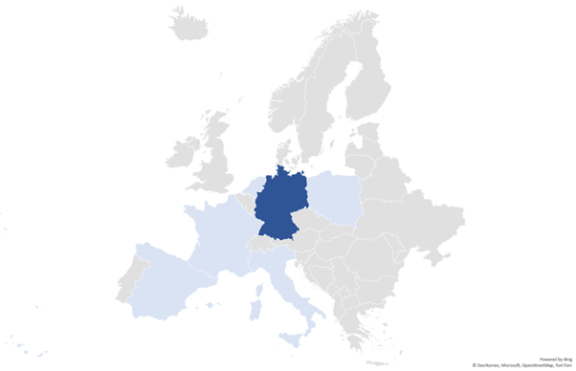
Germany is the largest swimwear import market in Europe. In 2022, the value of its swimwear imports amounted to €404 million, corresponding to approximately 62 million units of clothing. In the 2017-2022 period, the value of Germany’s swimwear imports increased at an average rate of 6.1% per year, equal to the overall segment growth rate, while its import volume increased by only 2.6%.
Table 3: 2022 imports of swimwear products to Germany, by segment, with 5-year growth, average import unit price and 5-year price evolution
|
|
Value in euros in 2022 |
Share |
5-year growth |
Average unit price in 2022 |
5-year price change |
|
Men’s & boys’ swimwear |
76.9 m |
19% |
5.6% |
6.65 |
1.99 |
|
Women’s & girls’ swimwear |
327.5 m |
81% |
6.2% |
6.46 |
0.72 |
|
All swimwear |
404.4 m |
100% |
6.1% |
6.5 |
1.00 |
The average unit price across gender subsegments is almost €1 higher in Germany than the European average (€5.56) and the highest among the top 6 markets. The average price paid for developing country imports (€4.48) is also among the highest in the top group. While men’s and boys’ swimwear prices have increased substantially over the 2017-2022 period, the segment is less strong in Germany compared to the EU overall, with only a 19% share and growth that is lower than the overall category growth rate.
Germany is a country with strict and increasing sustainability and circularity requirements, driven by national legislation and policies. Some German legislation on harmful chemicals goes beyond EU REACH legislation. It also has its own social and environmental standard, the Grüner Knopf label, which is displayed on garments at point of sale. Although investment in chemicals management and certification is required, this provides opportunities for higher-quality and sustainable products in line with the overall segment trends.
China remains the top exporter to Germany, but its market share is 20% below the European average and its growth stagnated in the 2017-2022 period, at an average of just 1.7% per year. This indicates that diversification away from China is already a well-established strategy. Germany is increasing its share of imports from within the EU and paying a higher premium (as much as €5.33) for intra-EU products compared to all but 1 of the other top 6 countries.
However, there are still opportunities for developing country suppliers than can design and source a range of synthetic and printed fabrics to take over the China business. For this reason, Cambodia and Vietnam (located close to China and its vast supply of synthetics) are leading among developing countries.
Key manufacturing countries closer to home include Poland (with a 21% market share), Italy (6.3% share) and Turkey (3.5% share).
These developments indicate that while the high volume/lower price market is still strong in Germany, there is also parallel demand for flexible production and high-quality, innovative products for which a high premium is paid.
Popular German brands selling swimwear include Bruno Banani, LASCANA, Adidas, Anekdot, Bogner, s.Oliver and About You. Specialist swimwear brands include Matia beachwear, MYMARINI and brands owned by the Maryan Beachwear Group.
France – a volume market with increasing sustainability requirements
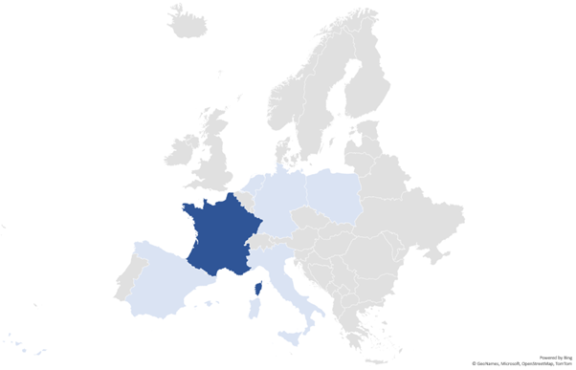
France is the second-largest swimwear import market in Europe. In 2022, the value of its swimwear imports amounted to €309 million, corresponding to approximately 60.2 million units of clothing. In the 5 years between 2017 and 2022, the value of France’s swimwear imports increased at an average rate of only 2.1% per year. This was far below the overall segment growth rate. Import volume increased by just 0.8%.
Table 4: 2022 imports of swimwear products to France, by segment, with 5-year growth, average import unit price and 5-year price evolution
|
|
Value in euros in 2022 |
Share |
5-year growth |
Average unit price in 2022 |
5-year price change |
|
Men’s & boy’s swimwear |
91.4 m |
29.6% |
7.9% |
5.06 |
1.04 |
|
Women’s & girls’ swimwear |
217.9 m |
70.4% |
0.2% |
5.18 |
0.06 |
|
All swimwear |
309.3 m |
100% |
2.1% |
5.14 |
0.32 |
France’s men’s and boys’ subsegment is slightly stronger than the European average, with positive price developments, higher-than-average growth and an almost 30% share of the market. However, although the women’s and girls’ subsegment is stagnating, its comparative size still makes it the most promising.
France can be described as a highly competitive, volume apparel market. Though not last among the top 6 markets, average unit prices for swimwear are below the European €5.56 average, and price increases in the past 5 years have fallen short of the European average of €0.78. Still, the average price paid for developing country imports is only €0.36 below that of the market leader, the Netherlands (€4.30).
There is also a significant luxury market in swimwear, following the wider lingerie market. In 2022, France sourced as much as 9.2% of its swimwear from Italy and this trend is expected to continue, with Italian swimwear exports to France growing by on average 9.8% annually in the 2017-2022 period. However, the premium paid for intra-EU imported swimwear is less than half that of Germany’s, at just €2.63.
France is stepping up its legislation on sustainability, and particularly chemicals legislation. It is now a legal requirement to inform customers at point of sale if products contain any substances on the REACH Substances of Very High Concern (SVHC) list. France is also the first EU country to impose specific MOSH/MOAH regulations for mineral oils often used in printing ink on packaging materials and recycled paper. Increased demand for more sustainable products and continued price pressure in the volume segment could present a challenge for suppliers.
Swimwear-specific French brands include GILI’S, ERES, Yasmin Eslami, Vilebrequin, Calarena, Anja Paris, Ysé and NOO Paris.
Italy – a global leader in swimwear design

Italy is the third-largest swimwear import market in Europe. In 2022, the value of its swimwear imports amounted to €229 million, corresponding to approximately 49.8 million units of clothing. Between 2017 and 2022, the value of Italy’s swimwear imports increased at an average rate of 5.1% per year. This was 1 percentage point below the overall segment growth rate, while import volume increased by just 3.7%.
Table 5. 2022 imports of swimwear products to Italy, by segment, with 5-year growth, average import unit price and 5-year price evolution
|
|
Value in euros in 2022 |
Share |
5-year growth |
Average unit price in 2022 |
5-year price change |
|
Men’s & boy’s swimwear |
82.1 m |
35.8% |
5% |
5.46 |
0.82 |
|
Women’s & girls’ swimwear |
147.4 m |
64.2% |
5.1% |
4.24 |
0.10 |
|
All swimwear |
229.5 m |
100% |
5.1% |
4.60 |
0.30 |
Italy has a well-established swimwear production industry (alongside lingerie and underwear) with a long tradition of manufacturing high-quality garments in elegant designs.
Italy has a strong beach culture, in particular during Ferragosto, when families and businesses take a month-long summer holiday. As a result, Italy has the strongest men’s and boys’ subsegment among the top 6 markets. This subsegment accounts for almost 36% of market imports, which is more than 10% above the European average. In general, Italian apparel focuses more on aesthetics, design and fit than on sustainability. However, this is likely to change as stricter EU regulations come into force.
Italy has the lowest average import price for swimwear among the top 6 markets, more than €1 under the European average. The average price paid for developing country imports is only €3.91, while the premium for intra-EU swimwear is just €1.64. The import market for swimwear is a lower cost, higher volume market, while much of the swimwear for Italy’s significant luxury/higher-end market is manufactured domestically. After China, France (whose brands share Italy’s luxury signature, but are sourced at volume prices) is Italy’s largest exporter of swimwear, with an 11% share of the market.
Many popular Italian lingerie brands also sell swimwear. Swimwear-specific brands include Sundalia, Lido, Grimaldimare, Calzedonia, Oseree and arena.
Spain – home to some of the largest international retailers in Europe
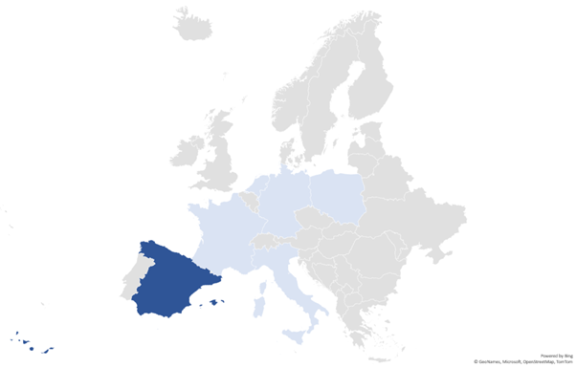
Spain is the fourth-largest swimwear import market in Europe. In 2022, the value of its swimwear imports amounted to €227 million, corresponding to approximately 49.1 million units of clothing. In the 5 years between 2017 and 2022, the value of Spain’s swimwear imports increased at an average rate of 6% per year. This was in line with the overall segment growth rate, while import volume increased by 6.2%.
Table 6: 2022 imports of swimwear products to Spain, by segment, with 5-year growth, average import unit price and 5-year price evolution
|
|
Value in euros in 2022 |
Share |
5-year growth |
Average unit price in 2022 |
5-year price change |
|
Men’s & boy’s swimwear |
57.7 m |
25.3% |
5.2% |
4.71 |
0.27 |
|
Women’s & girls’ swimwear |
170 m |
74.7% |
6.3% |
4.61 |
-0.17 |
|
All swimwear |
227.7 m |
100% |
6% |
4.63 |
-0.05 |
With its long, hot summers, Spain – like Italy – has a strong beach culture and this heavily influences demand. Much of Spain’s imports go to a few large international fast fashion retailers. As a result, import statistics may not reflect the country’s relatively low GDP, average wages and underperforming local market. Prices paid by Spain’s importers are among the lowest of the top importing countries. The average import price was almost €1 below the European average of €5.56 in 2022, which is a decrease compared to 2017. The average price for developing country imports was only €3.72, higher than only Poland among the group of top importers.
China remains Spain’s strongest exporter of swimwear, with a 32% market share in 2022 and a healthy annual growth rate that is 2 percentage points higher than the category average over the 2017-2022 period.
Popular Spanish brands selling swimwear include Mango and Zara. Swimwear-specific brands include XTG Extreme Game, Lisa Marie Fernandez and SURO Swimwear.
The Netherlands – a distribution hub and European centre for sustainability initiatives
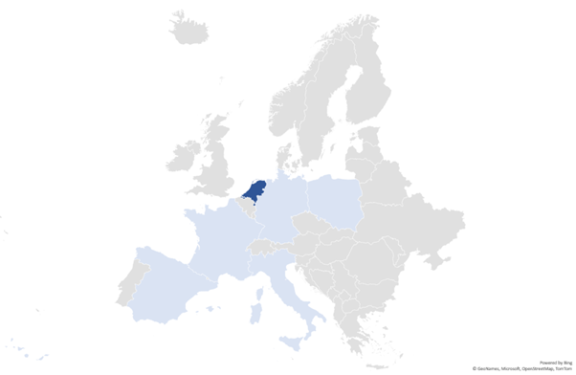
The Netherlands is the fifth-largest swimwear import market in Europe. In 2022, the value of its swimwear imports amounted to €221 million, corresponding to approximately 37.1 million units of clothing. In the 2017-2022 period, the value of the Netherlands’ swimwear imports increased at an average rate of 7.3% per year. This was more than 1 percentage point above the overall segment growth rate, while import volume increased by only 2.5%.
Table 7: 2022 imports of swimwear products to the Netherlands, by segment, with 5-year growth, average import unit price and 5-year price evolution
|
|
Value in euros in 2022 |
Share |
5-year growth |
Average unit price in 2022 |
5-year price change |
|
Men’s & boy’s swimwear |
57.4 m |
25.9% |
10.6% |
5.20 |
1.48 |
|
Women’s & girls’ swimwear |
163.9 m |
74.1% |
6.3% |
6.27 |
1.16 |
|
All swimwear |
221.3 m |
100% |
7.3% |
5.95 |
1.23 |
The Netherlands profits from a favourable business climate that facilitates importing and exporting. This, combined with its nearness to the sea and availability of harbours, makes it an ideal hub for imports into Europe. For this reason, many established foreign apparel brands have their headquarters in the Dutch capital, including Nike, Karl Lagerfeld and Tommy Hilfiger.
The Netherlands is home to a strong community of industry support organisations focused mainly on sustainability issues. They include Fashion for Good (an innovation platform and accelerator for fashion start-ups), MODINT (trade association) and the non-profit Sustainable Apparel Coalition.
China remains the strongest exporter of swimwear to the Netherlands, with a 34.6% market share. Six of the country’s top ten swimwear exporters are developing countries, all in Asia (China, Vietnam, Sri Lanka, Bangladesh, Indonesia and Myanmar). Except Bangladesh and China, all saw growth significantly higher than the Netherlands’ import growth during the 2017-2022 period, indicating that the Netherlands is increasing its sourcing from both established and emerging Asian countries.
Average prices are among the highest within the top group of importers, with positive price developments over the 2017-2022 period. Prices paid for developing country imports are the highest among the top 6 markets (€4.66). The Netherlands pays a relatively high premium for intra-EU imports compared to developing country imports (€4.59).
Popular Dutch fashion, sportswear and lingerie brands that sell swimwear include Tommy Hilfiger, Bever, D-AMS, Marlies Dekkers, Hunkemöller, MamaMaria, Tommy Hilfiger and Protest.
Poland – fastest growing economy in Europe
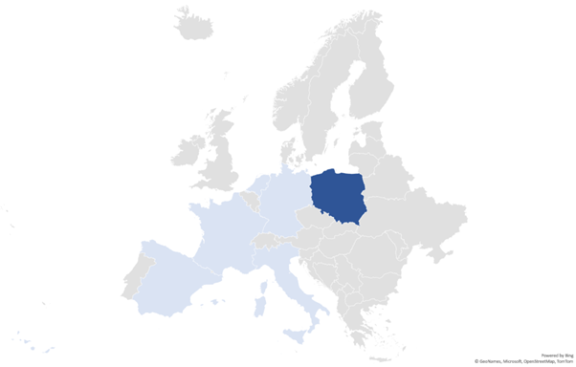
Poland is the sixth-largest swimwear import market in Europe. In 2022, the value of its swimwear imports amounted to €154 million, corresponding to approximately 25.9 million units of clothing. In the 5 years between 2017 and 2022, the value of Poland’s swimwear imports increased at an average rate of 16.4% per year. This was more than two and a half times the overall segment growth rate, while import volume increased by 14.2%.
Table 8: 2022 imports of swimwear products to Poland, by segment, with 5-year growth, average import unit price and 5-year price evolution
|
|
Value in euros in 2022 |
Share |
5-year growth |
Average unit price in 2022 |
5-year price change |
|
Men’s & boy’s swimwear |
30.8 m |
19.9% |
22.6% |
4.65 |
0.69 |
|
Women’s & girls’ swimwear |
124 m |
80.1% |
15.2% |
6.41 |
0.59 |
|
All swimwear |
154.8 m |
100% |
16.4% |
5.96 |
0.54 |
Women’s and girls’ swimwear is the stronger subsegment in Poland, with an 80% share of the market and higher average unit prices, although the men’s and boys’ subsegment is growing faster.
Poland is currently not a suitable market for value-added or sustainable products, as it has a low GDP and wages and sustainability awareness is lower. Prices are relatively high now, but this is likely due to the use of more indirect distribution channels (such as wholesalers) and a high level of intra-EU imports from countries such as Germany (43% share), France (5.8% share) and the Netherlands (5.4% share).
In the future, as Poland’s economy continues to expand and domestic brands establish themselves, Polish imports from developing countries are also expected to grow. These imports already increased significantly (28.6%) in the past 5 years. With a 2022 share of only 22.3% compared to the European average of 43.5%, developing country exporters will have many opportunities to increase exports to Poland in the short and medium term.
China and Bangladesh are the only developing countries among the top ten swimwear exporters to Poland, with market shares of 13% and 6.5%, respectively. Bangladesh’s exports soared in the 2017-2022 period, increasing by as much as 143% per year on average. This is reflected in the average price paid by Poland for developing country swimwear imports, which is only €2.98 per unit.
Poland’s largest fashion manufacturer is LPP, which manages brands including Reserved, CROPP, House, MOHITO and Sinsay. Underwear brands that also sell swimwear include Ewa Bien and Dalia.
Tips:
- Consider entering the women’s swimwear segment first, as it is the larger segment for each of these markets, offering a lot of variety and entry options.
- Visit (in person or online) key European swimwear trade fairs including Supreme Body & Beach (Germany), Maredamare (Italy), Salon International de la Lingerie & Interfilière Paris (France). A list of trade shows can be found here.
4. Which trends offer opportunities or pose threats on the European swimwear market?
The European swimwear market follows general apparel industry trends and developments in sustainability, circularity and corporate social responsibility, which are driven largely by policy initiatives under the EU Green Deal.
The swimwear segment has its own set of sustainability challenges. Swimwear has to withstand many elements (sun, heat, salt water, oil, sunscreen and chlorine) and extra performance functionality is highly desired (such as high stretch and recovery, anti-UV and quick drying properties). There is currently no natural or more sustainable fibre that offers all swimwear performance qualities. Research and development is therefore mainly focused on minimising the harmful effects of synthetic materials.
Use of materials made of recycled inputs is increasing. However, for hygiene reasons, circular business models such as subscriptions, rentals and resale (which are becoming more popular in the apparel industry) are not possible for swimwear and other intimate apparel. Neither is fibre-to-fibre recycling, as fabrics are usually blended with elastane. Circularity is generally limited to take-back schemes through which garments are downcycled rather than used to make new, quality products.
Trend 1 – Digitally native brands are driving growth through inclusivity
Results of a European Health Survey done between 2018 and 2020 show that more than 45% of European women are either overweight or obese. Growing availability of product options for a more diverse range of consumers is propelling market growth in the women’s swimwear segment. This includes compression/shaping swimwear, styles that provide more coverage and larger size ranges. In advertising, there is also a clear shift from messaging centring on sex appeal (to men) towards messaging that promotes women’s empowerment and body positivity (being comfortable in one’s skin).
As swimwear is unquestionably the most ‘vulnerable’ piece of clothing a woman wears in public, the women’s swimwear market is one of the biggest drivers of these trends, which are expected to strength in the future. Digitally native brands (those operating wholly or mostly online) are leading the way and are also among the brands most focused on promoting sustainability values.
Trend 2 – Materials made of recycled inputs are becoming a basic requirement
There is growing consumer awareness about the harmful effects of conventional fibre production. A 2020 survey of British and German consumers by consulting company McKinsey found the use of sustainable materials to be an important purchasing factor for 67% of respondents.
Petroleum-based synthetic materials such as nylon, polyester and elastane are widely used in the swimwear segment due to their durability and performance characteristics. However, these materials are made from non-renewable resources in an energy-intensive process and are not biodegradable. There is a strong push within the swimwear segment to develop more sustainably produced performance fabrics, particularly those that protect, or minimise negative impacts on, the world’s oceans.
According to a 2019 Greenpeace report (PDF), a staggering 12 million tonnes of plastic ends up in the ocean every year, the same as emptying one rubbish truck into the ocean every minute. The 2 most common yarns made from recycled plastic (including nylon) waste used in the swimwear segment are REPREVE® (by Unifi) and ECONYL® (by Aquafil).
REPREVE® is polyester fibre made from recycled plastic bottles that have been diverted from landfill and oceans. ECONYL® yarn uses nylon (a form of plastic) waste from old carpets, fishing nets, marine debris and pre-consumer waste to create regenerated nylon with the same properties, performance and quality as new nylon.
Aquafil’s 2022 sustainability report (PDF) states that more than 2,500 brands are using ECONYL® and that sales of ECONYL® increased by as much as 52% in 2022. It is fast becoming a must-have among swimwear brands. With upcoming EU legislation potentially restricting the use of recycled plastic bottles in textiles, the dominance of ECONYL® is expected to increase.
Trend 3 – Sun-protective swimwear is on the rise as climate change continues
According to Statista, 7 of the 10 countries with the highest rates of skin cancer as a percentage of the population are in Europe (the other 3 are Australia, New Zealand and Switzerland). This is due in large part to these countries’ relatively fair-skinned populations. Awareness about this is starting to change the behaviour of sunseekers and people who engage in outdoor activities. Many try to cover up more and most use a high SPF sunscreen. As children’s skin is even more delicate than adult skin, protecting children from the harmful effects of the sun while swimming has become a top priority among parents.
More and more sun-protective swimwear that caters to these concerns is coming onto the market. This includes swimwear that covers more of the body (rash vests and wetsuit styles are gaining popularity) as well as swimwear that has a guaranteed UPF (ultraviolet protection factor) of up to 50+ through material construction, composition, colour and/or UV-blocking technologies.
UniJoy
UniJoy in China is a BSCI-certified manufacturer of swimwear for men, women and children, including swim shorts, bikinis and UV-protective rash guards. The company has experience using Global Recycled Standard-certified materials and produces styles from several recycled materials, including yarns such as ECONYL and Unifi.
Tips:
- Visit the ECONYL® e-shop, showcasing all products made from ECONYL® nylon. A significant portion of the 518 brands listed at the time of writing were European swimwear brands.
- Read post-trade fair reports about new product introductions and innovations, including Germany’s Techtextil, the leading international trade fair for technical textiles.
- Visit the websites of ocean protection initiatives such as Healthy Seas, a nonprofit organisation dedicated to removing ‘ghost fishing gear’ (abandoned, lost and discarded gear) and marine debris from the seas. Many European brands support this initiative and the website clearly outlines how manufacturers can get involved and offers marketing communication support.
- Create your own sustainability ‘story’, including website and social media content to communicate your values and your activities in the local community.
- Check out the websites of your target brands/retailers to see how they are marketing their sustainability to end consumers. This can include certifications, testing requirements, community projects in production locations and/or material use targets. Think about ways that you can add value.
FT Journalistiek carried out this study on behalf of CBI.
Please review our market information disclaimer.
Search
Enter search terms to find market research
